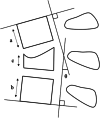Correction loss following short-segment posterior fixation for traumatic thoracolumbar burst fractures related to endplate and intervertebral disc destruction
- PMID: 36890495
- PMCID: PMC9993651
- DOI: 10.1186/s12891-023-06288-y
Correction loss following short-segment posterior fixation for traumatic thoracolumbar burst fractures related to endplate and intervertebral disc destruction
Abstract
Background: There has been widespread use of short-segment posterior fixation (SSPF) for traumatic thoracolumbar burst fractures. The relationship between the destruction of the vertebral endplate and adjacent disc and postoperative correction loss has been studied in only a few studies. This study investigated the risk factors for correction loss following SSPF.
Methods: Forty-eight patients (mean age 35.0 years) who underwent SSPF for thoracolumbar burst fractures were enrolled. The mean follow-up period was 25.7 months (12-98 months). The neurological status and postoperative back pain were assessed by the medical records. Segmental kyphotic angle (SKA) and anterior vertebral body height ratio (AVBHR) were measured radiographically to assess indirect vertebral body reduction and local kyphosis. Preoperative Sander's traumatic intervertebral disc lesion (TIDL) classification and AO classification were used to evaluate the severity of disc and vertebral endplate injury. The corrective loss was considered present if ΔSKA was ≥10°. A multivariate logistic regression analysis was performed to identify the risk factors associated with postoperative loss of correction.
Results: The fracture distribution was as follows: 10 at T12, 17 at L1, 10 at L2, 9 at L3, and 2 at L4. Vertebral fractures were classified in the following way: A3 in 13 patients, A4 in 11, B1 in 11, and B2 in 13. In 47 patients (98%), a union of the fractured vertebrae was achieved. SKA and AVBHR improved significantly after surgery from 11.6° to 3.5° and from 67.2 to 90.0%, respectively. However, the correction loss at follow-up was 10.4° and 9.7%, respectively. Twenty patients (42%) had severe TIDL (grade 3). Postoperative ΔSKA and ΔAVBHR were significantly higher in patients with TIDL grade 3 than with TIDL grade 0-2. The presence of cranial TIDL grade 3 and older age were significant risk factors for ΔSKA ≥10° on multivariate logistic regression analysis. All patients could walk at follow-up. TIDL grade 3 and ΔSKA ≥10° were associated with severe postoperative back pain.
Conclusions: Risk factors for loss of correction after SSPF for thoracolumbar burst fractures were severe disc and endplate destruction at the time of injury and older age.
Keywords: Correction loss; Endplate injury; Short-segment posterior fusion; Thoracolumbar burst fractures; Traumatic intervertebral disk lesion.
© 2023. The Author(s).
Conflict of interest statement
The authors declare no competing interests.
Figures




Similar articles
-
Impact of traumatic intervertebral disc injury on loss of correction following pedicle screw fixation for thoracolumbar fractures.BMC Musculoskelet Disord. 2025 May 23;26(1):507. doi: 10.1186/s12891-025-08759-w. BMC Musculoskelet Disord. 2025. PMID: 40410692 Free PMC article.
-
Direct reduction of thoracolumbar burst fractures by means of balloon kyphoplasty with calcium phosphate and stabilization with pedicle-screw instrumentation and fusion.Spine (Phila Pa 1976). 2008 Feb 15;33(4):E100-8. doi: 10.1097/BRS.0b013e3181646b07. Spine (Phila Pa 1976). 2008. PMID: 18277858
-
Which patients risk segmental kyphosis after short segment thoracolumbar fracture fixation with intermediate screws?Injury. 2016 Oct;47 Suppl 4:S29-S34. doi: 10.1016/j.injury.2016.07.048. Epub 2016 Aug 3. Injury. 2016. PMID: 27496720
-
Analysis of intervertebral discs adjacent to thoracolumbar A3 fractures treated by percutaneous instrumentation and kyphoplasty.Orthop Traumatol Surg Res. 2020 Oct;106(6):1221-1226. doi: 10.1016/j.otsr.2020.05.006. Epub 2020 Sep 2. Orthop Traumatol Surg Res. 2020. PMID: 32888918 Review.
-
Malunion of post-traumatic thoracolumbar fractures.Orthop Traumatol Surg Res. 2018 Feb;104(1S):S55-S62. doi: 10.1016/j.otsr.2017.04.018. Epub 2017 Nov 27. Orthop Traumatol Surg Res. 2018. PMID: 29191468 Review.
Cited by
-
Bone density as a risk of early loss of correction after percutaneous posterior spinal fixation for traumatic thoracolumbar fracture: a study on the usefulness of Hounsfield unit values on computed tomography scan.Eur Spine J. 2025 Feb;34(2):498-505. doi: 10.1007/s00586-024-08508-y. Epub 2024 Oct 5. Eur Spine J. 2025. PMID: 39368028
-
Defining threshold for sagittal correction in lumbar fractures.Eur Spine J. 2024 Apr;33(4):1550-1555. doi: 10.1007/s00586-024-08138-4. Epub 2024 Feb 5. Eur Spine J. 2024. PMID: 38315226 Review.
-
[Indications for surgical treatment of traumatic fractures of the thoracic spine and lumbar spine].Unfallchirurgie (Heidelb). 2025 Mar;128(3):156-166. doi: 10.1007/s00113-024-01518-x. Epub 2025 Jan 27. Unfallchirurgie (Heidelb). 2025. PMID: 39869224 Review. German.
-
[Effectiveness of injured vertebra fixation with inclined-long pedicle screws combined with interbody fusion for thoracolumbar fracture dislocation with disc injury].Zhongguo Xiu Fu Chong Jian Wai Ke Za Zhi. 2024 Apr 15;38(4):466-473. doi: 10.7507/1002-1892.202310042. Zhongguo Xiu Fu Chong Jian Wai Ke Za Zhi. 2024. PMID: 38632068 Free PMC article. Chinese.
-
Impact of traumatic intervertebral disc injury on loss of correction following pedicle screw fixation for thoracolumbar fractures.BMC Musculoskelet Disord. 2025 May 23;26(1):507. doi: 10.1186/s12891-025-08759-w. BMC Musculoskelet Disord. 2025. PMID: 40410692 Free PMC article.
References
-
- Toyone T, Tanaka T, Kato D, Kaneyama R, Otsuka M. The treatment of acute thoracolumbar burst fractures with transpedicular intracorporeal hydroxyapatite grafting following indirect reduction and pedicle screw fixation: a prospective study. Spine (Phila Pa 1976) 2006;31:E208–E214. doi: 10.1097/01.brs.0000208161.74286.ad. - DOI - PubMed
-
- Knop C, Fabian HF, Bastian L, Blauth M. Late results of thoracolumbar fractures after posterior instrumentation and transpedicular bone grafting. Spine (Phila Pa 1976). 2001;(26):88–99. 10.1097/00007632-200101010-00016. - PubMed
-
- Aono H, Ishii K, Takenaka S, Tobimatsu H, Nagamoto Y, Horii C, Yamashita T, Furuya M, Iwasaki M. Risk factors for a kyphosis recurrence after short-segment temporary posterior fixation for thoracolumbar burst fractures. J Clin Neurosci. 2019;66:138–143. doi: 10.1016/j.jocn.2019.04.035. - DOI - PubMed
-
- Chen JX, Xu DL, Sheng SR, Goswami A, Xuan J, Jin HM, Chen J, Chen Y, Zheng ZM, Chen XB, Wang XY. Risk factors of kyphosis recurrence after implant removal in thoracolumbar burst fractures following posterior short-segment fixation. Int Orthop. 2016;40:1253–1260. doi: 10.1007/s00264-016-3180-9. - DOI - PubMed
MeSH terms
LinkOut - more resources
Full Text Sources
Medical

